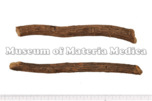Red Peony Root

|
Market name:赤芍 Photo location:Museum of Materia Medica, Inst. of Nat. Med. TMPW No.:25047 |

|
Plant name:Paeonia veitchii Photo date:1996 Photographer:K. Komatsu |
| Synonym | |
| Latin name | Paeoniae Radix Rubra |
| Botanical source: Family name | Paeoniaceae |
| Botanical source: Plant name | Paeonia lactiflora Pallas (IPNI:711802-1) |
| Part used | Root with epidermis |
| Empirical criteria for quality selection | Root thick and long; outer bark easily exfoliated; surface longitudinally furrowed and wrinkled deeply; fracture white in color and rich in powder. |
| Constituents | Monoterpenoids: [P. lactiflora Pall. var. trichocarpa Stern.: Paeoniflorin, Albiflorin, Oxypaeoniflorin, Paeoniflorigenone, Paeonilactones; [P. albiflora Pall. var. trichocarpa Bunge (metabolites): Paeonilactone-A, Paeonilactone-B, Paeonilactone-C; [P. albiflora Pall.]: Paeoniflorin, Oxypaeoniflorin, Benzoylpaeoniflorin, Desbenzoylpaeoniflorin, Albiflorin, Paeoniflorigenone, 6-OAcetylpaeoniflorigenone, and the following are metabolites: 7S-Paeonimetaboline I, 7R-Paeonimetaboline I, 6-OAcetylpaeonimetaboline I, Paeonimetaboline II, Paeonimetaboline III, Paeonilactone-A (Metabolite-A1), Paeonilactone-B (Metabolite-A2), Metabolite A1-acetate, 7S-Paeonimetaboline-6-O-3,5-dinitrophenyl carbamate, 7R-Paeonimetaboline-6-O-3,5-dinitrophenyl carbamate, 7S-8-(2-Carboxyethylthio)paeonimetabolin I, 7R-8-(2-Carboxyethylthio)paeonimetabolin I, 7S-8-(2-Hydroxyethylthio)paeonimetabolin I, 7R-8-(2-Hydroxyethylthio)paeonimetabolin I, 7S-8-Benzoylthiopaeonimetabolin I, 7R-8-enzoylthiopaeonimetabolin I, 7R-8-(Carboxymethylthio)paeonimetabolin I, 7S-8-(Carboxymethylthio)paeonimetabolin I, 7R-8-(2'-Carboxyethylthio)paeonimetabolin I, 7S-8-(2'-Carboxyethylthio)paeonimetabolin I, 7R-8-(5'-Carboxyethylthio)paeonimetabolin I, 7S-8-(5'-Carboxyethylthio)paeonimetabolin I, Pentaacetylpaeoniflorin, Tetraacetylpaeoniflorin, Albimetaboline I, Albimetaboline II; [P. albiflora (metabolites)]: 7S-Paeonimetaboline I, 7R-Paeonimetaboline I, Paeonimetaboline II, Paronimetaboline III Triterpenoids: [P. albiflora]: Palbinone Tannins: Tetra~Undecagalloylglucose, d-Catechin, Procyanidin B-1; [P. lactiflora var. trichocarpa]: Tetragalloylglucose, Pentagalloylglucose, Hexagalloylglucose; [P. albiflora]: Gallotannins Other aromatic compounds: [P. lactiflora var. trichocarpa]: Benzoic acid |
| Pharmacological effects | Antiinflammatory, antihypertensive, sedative (paeoniflorin). Inhibition of stress ulcer. Antispasmodic, improvement of experimental spatial cognitive impairment (water extract, paeoniflorin). Central antispasmodic effect (paeoniflorin, paeonimetabolin I). Antibacterial (Staphylococcus aureus and etc). |
| Indications | It is effective for invigorating blood, breaking stagnation and resolving swollen abscesses. It is applied to treat pain in lower abdomen and lumbar backache caused by blood heat stagnation. It is also used to treat gynecological disease such as menopause. |
| Diseases | Lower back pain, Abdominal pain, Swelling and pain due to contusion, Anginal pain, Nasal hemorrhage, Irregular menstruation |
| Formulas | |
| Meridian tropism | Liver |
| Property | Slightly cold |
| Flavor | Bitter |
| Classification in "Shen-non Ben-cao Jing" | |
| TCM: Classification | Drugs for eliminating pathological heat from blood |
| TCM: Medicinal effects | To clear heat and cool the blood, dissipate stasis and relieve pain. Used for heat entering nutrient-blood aspects, macula and papule caused by warm toxin, hematemesis and epistaxis, red painful swelling eyes, liver depression with hypochondriac pain, amenorrhea and dysmenorrhea, abdominal pain caused by aggregation and accumulation, injuries from falls, swelling abscess, sore and ulcer. |
| Remarks | |
| References |
DNA sequences of medicinal plants
| Gene Region | |||||||||||||||||||
| Nuclear | Chloroplast | Mitochondria | |||||||||||||||||
| Botanical source: Plant name | 5Ss | 18S | ITS1 | 5.8S | ITS2 | 26S | others | trnH-psbA | matK | trnK | trnK-rps16 | trnT-L | trnL | trnL-F | rbcL | rpoC1 | ndhF | others | |
|
|
|||||||||||||||||||
